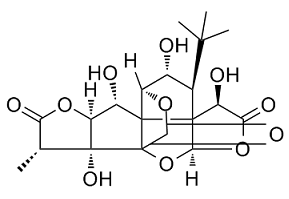
Ginkgolide C (10-100 μM) significantly suppresses lipid accumulation compared with the control group and also significantly promotes glycerol release in 3T3-L1 adipocytes. Ginkgolide C suppresses PPAR-α and PPAR-γ expression and decreases C/EBPα, C/EBPβ, and SREBP-1c expression in differentiated 3T3-L1 adipocytes. Ginkgolide C (3-100 μM) also significantly promotes Sirt1 production and increases phosphorylation of AMPKα and ACC-1 in a concentration-dependent manner. Ginkgolide C (1, 10, 50, 100, 500 mM) significantly reduces the collagen (10 mg/mL)-stimulated rat platelet aggregation in a dose-dependent manner. Ginkgolide C (50, 100 mM) causes pro-MMP-9 (92-kDa) to form an activated MMP-9 (86-kDa) in collagen-stimulated platelets.
| Cell Experiment | |
|---|---|
| Cell lines | 3T3-L1 cells |
| Preparation method | 3T3-L1 cells are treated with various concentrations of ginkgolide C in 96-well plates for 24 h. Cell viability is analyzed by the MTT assay. The culture medium is removed, and the cells are incubated with 100 μL MTT solution (5 mg/mL) for 4 h at 37°C. After plates are washed, isopropanol is added to dissolve formazone crystals, followed by absorbance detection with a spectrophotometer at 570 nm. |
| Concentrations | 3 μM-100 μM |
| Incubation time | 24 h |
| Animal Experiment | |
|---|---|
| Animal models | |
| Formulation | |
| Dosages | |
| Administration | |
| Molecular Weight | 440.4 |
| Formula | C20H24O11 |
| CAS Number | 15291-76-6 |
| Solubility (25°C) | DMSO: ≥ 100 mg/mL |
| Storage |
Powder -20°C 3 years ; 4°C 2 years In solvent -80°C 6 months ; -20°C 1 month |
| Species | Mouse | Rat | Rabbit | Guinea pig | Hamster | Dog |
| Weight (kg) | 0.02 | 0.15 | 1.8 | 0.4 | 0.08 | 10 |
| Body Surface Area (m2) | 0.007 | 0.025 | 0.15 | 0.05 | 0.02 | 0.5 |
| Km factor | 3 | 6 | 12 | 8 | 5 | 20 |
| Animal A (mg/kg) = Animal B (mg/kg) multiplied by | Animal B Km |
| Animal A Km |
For example, to modify the dose of Compound A used for a mouse (20 mg/kg) to a dose based on the BSA for a rat, multiply 20 mg/kg by the Km factor for a mouse and then divide by the Km factor for a rat. This calculation results in a rat equivalent dose for Compound A of 10 mg/kg.
| Related AMPK Products |
|---|
| SAMS
SAMS peptide is a specific substrate for the AMP-activated protein kinase (AMPK). |
| Marein
Marein has the neuroprotective effect due to a reduction of damage to mitochondria function and activation of the AMPK signal pathway. |
| Malvidin-3-O-arabinoside chloride
Malvidin-3-O-arabinoside chloride ameliorates ethyl carbamate-induced oxidative damage by stimulating AMPK-mediated autophagy. |
| AMPK activator 12
AMPK activator 12 is a potent AMPK activator and GDF15 inducer. |
| Kazinol U
Kazinol U inhibits melanogenesis through the inhibition of tyrosinase-related proteins via AMPK activation. |


Products are for research use only. Not for human use. We do not sell to patients.
© Copyright 2010-2023 AbMole BioScience. All Rights Reserved.
